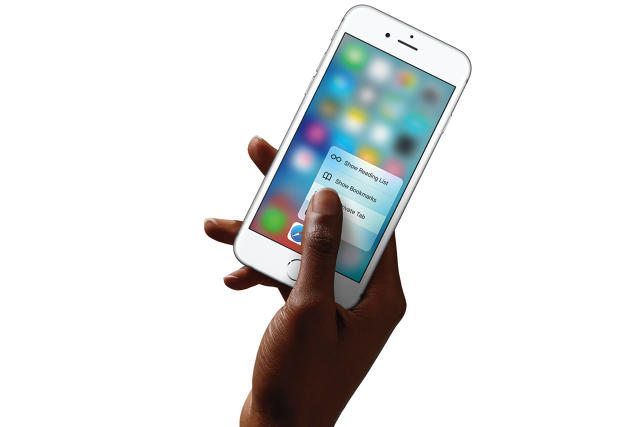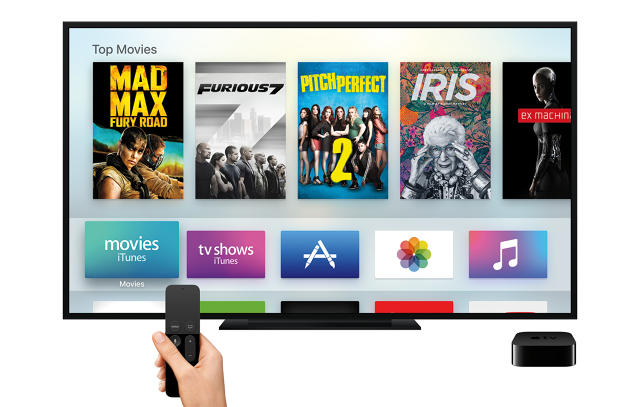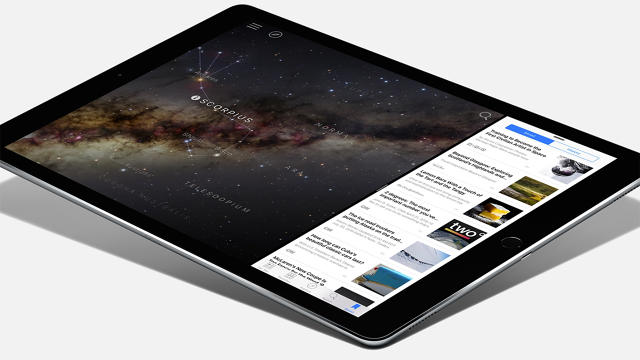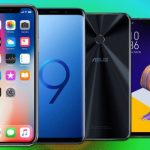Apple’s New iPhones, iPad, Apple TV and Apple Watch: What You Should Know From Your Wrist to Your TV
Your 2-minute guide to the most important things Apple announced today.
The iPhone 6s is here. And it brought with it several bigger cousins.
As expected, Apple unveiled the iPhone 6s and iPhone 6s Plus today at its annual fall product launch event in San Francisco. Despite their familiar looks, the phones sport a new aluminum exterior, new colors, and a new feature called 3D Touch (essentially Force Touch for the iPhone). 3D Touch allows the phone to recognize the degree of force being used in touch gestures—a mini-tap vs. a full tap, for instance—and respond accordingly. While navigating the iOS interface, 3D Touch can serve as a new sort of “right click” functionality, calling up menus and allowing users to preview content from outside of a given app. It also opens up new possibilities for playing (and developing) mobile games.
The iPhone 6s will ship with Apple’s new A9 chip, which promises to be 70% faster than the A8 chip found in the iPhone 6.
As expected, both phones are getting camera upgrades. The iSight camera now packs 12 megapixels and shoots super high-def 4K video. Meanwhile, the front-facing FaceTime camera is now at 5 megapixels and has a front-facing flash. Apple is also debuting a new feature called Live Photos, which turns still photos into mini-animations.

As usual, both new iPhone models start at 16 GB (somewhat surprising, considering the growing footprint of iOS and the amount of extra space Live Photos must eat up) and come in 64 GB and 128 GB models. The pricing of the new phones is the same as that of the iPhone 6 and 6 Plus: The iPhone 6s starts at $199 (16 GB) and ranges up to $399 (128 GB), while the 6s Plus starts at $299 (16 GB) and gets as pricey as $499 (128 GB). And for the first time, Apple is offering an upgrade plan that lets users buy unlocked phones and upgrade them every year, starting at $32/month.
The iPhone 6s and 6s Plus will be available for pre-orders on September 12 and start shipping September 25. Meanwhile, iOS 9 will be available for download on September 16th.
iPhone 6s and 6s Plus specs:
– A9 chip (3rd generation 64-bit chip)
– 3D Touch
– 12 MP iSight camera
– 4K video support
– 5 MP FaceTime HD camera
– Live Photos
– Stronger cover glass
– 2nd generation Touch ID
Apple Overhauls The Apple TV
Apple also gave an overdue refresh to the Apple TV. Most crucially, the set-top box will now support third-party apps.
“Our vision for TV is simple, and perhaps a little provocative,” said Apple CEO Tim Cook before unveiling the new Apple TV. “We believe the future of television is apps.”
The device also has a redesigned remote, which includes a touch pad and can be used as a game controller. As predicted, the device now also supports Siri voice control. It will ship with universal search, which will allow users to search for content across apps like Netflix, Hulu, HBO Now, and Showtime.
While the overall user interface looks very familiar, the functionality of the Apple TV appears poised to change substantially, thanks to the integration of Siri and universal search. For instance, viewers can ask Siri for a specific episode of a specific show, or even an episode guest-starring a particular actor. As is typically the case with Apple, the name of the game here is usability. And with this update to Apple TV, the company is taking its most sincere crack yet at the fractured, imperfect design of Internet-based television and movie watching.
The Apple TV operating system now has a name: tvOS. The new OS, which Eddy Cue says is “based on iOS and built for the living room,” also has a new suite of software development kit to let developers build new TV apps, including games—a use case Apple is pushing pretty hard, given how popular games have proven to be on the iPad and iPhone.
Apple also partnered with MLB to create new Apple TV-specific sports apps, promising to help scratch an itch often cited by those hesitant to cut the cord from cable. But the Apple TV won’t be limited to video content, music, and games. Shopping app Gilt also demoed its upcoming Apple TV app on stage at today’s event, and Cue mentioned the impending arrival of an Airbnb app on the Apple TV.

The new Apple TV, which comes in 32GB and 64GB versions, will ship in late October.
Apple TV specs:
– Redesigned remote control featuring a touchpad, accelerometer, and gyroscope
– Siri voice control
– Developer kit and third-party app store
– Universal, cross-app video search
– tvOS operating system
– Bluetooth 4.0
– 64 bit A8 chip

The Rumors Were True: The iPad Pro Is Coming
As expected, Apple previewed the latest addition to its tablet lineup as well: the iPad Pro. It sports a 12.9-inch screen with 5.6 million pixels, which is a higher resolution than the display on the MacBook Pro with Retina. Its new A9X chip promises “desktop class performance” that is faster than 80% of portable PCs on the market. The iPad Pro will ship in November.
For the first time, an iOS device will have a physical keyboard. In addition to a case that includes a keyboard, the iPad Pro will also support the Apple Pencil, the first Apple-built stylus for an iOS device. The Apple Pencil can be charged using the iPad Pro’s lightning connector port. Both the iPad Pencil and the keyboard ship separately as add-on accessories.
The launches of iPad Pro and Apple Pencil present new opportunities for developers. One early partners is Microsoft, which shared the stage with Apple to show off new productivity features in Office for iPad. Apps like Word and Excel have been fine-tuned to work specifically with the iPad Pro and Apple Pencil.
Speaking of Apple rivals, Apple has also been working with Adobe to build apps for the iPad Pro. Adobe announced Photoshop Fix, a new app that was built for the iPad Pro first. Eric Snow, the director of design for mobile apps at Adobe, demoed how Fix can work with other Adobe mobile apps like Comp and Sketch, which have been custom-tweaked for the iPad Pro as well. The new iPad-only Adobe workflow will be available in October. TypeKit fonts are now available on a mobile device for the first time.
Apple also added the iPad Mini 4 ($400), which is essentially the iPad Air 2 but smaller. The iPad Mini 2 is now available for $269.

iPad Pro specs:
– 12.9 inch screen (“The biggest we’ve ever built in an iOS device,” says Phil Schiller)
– The display sports 5.6 million pixels
– A9X chip (double the memory bandwidth and 2x faster storage performance of the previous chip, the A8X)
– 10 hours of battery life.
– Four-speaker audio system with 3 times the audio volume of the iPad Air 2.
– 6.9 millimeters thick (vs. the iPad Air 2 at 6.1mm)
– New cover that has a built-in physical keyboard
– Apple Pencil, the first Apple-built stylus for an iOS device
– Touch ID
– 8 megapixel iSight camera
– Up to 150 mbps LTE connectivity
– Comes in silver, gold, and grey

Apple Watch Updates
Before beefing up its lineup across bigger screens, Apple gave a quick update on the Apple Watch, which now boasts over 10,000 apps, including new additions like Facebook Messenger and a GoPro app. The company also announced new watch bands and product designs, including a strap co-created with Hermes. The Apple Watch will come in two new finishes: rose gold and gold, both in anodized aluminum. There are also new Sport models available, which start shipping today.
Apple is also pushing the medical use cases for Apple Watch pretty hard. Apple invited Dr. Cameron Powell to demo an app called AirStrip, which promises to “change how doctors interact with their patients.” Doctors can view live feeds of patients’ medical data (including their heart rate), as well as their schedules, using the AirStrip app for Apple Watch.
Watch OS 2 will be available for download on September 16.
Related: The History of Apple in Under 3 Minutes
Fast Company , Read Full Story
(161)














